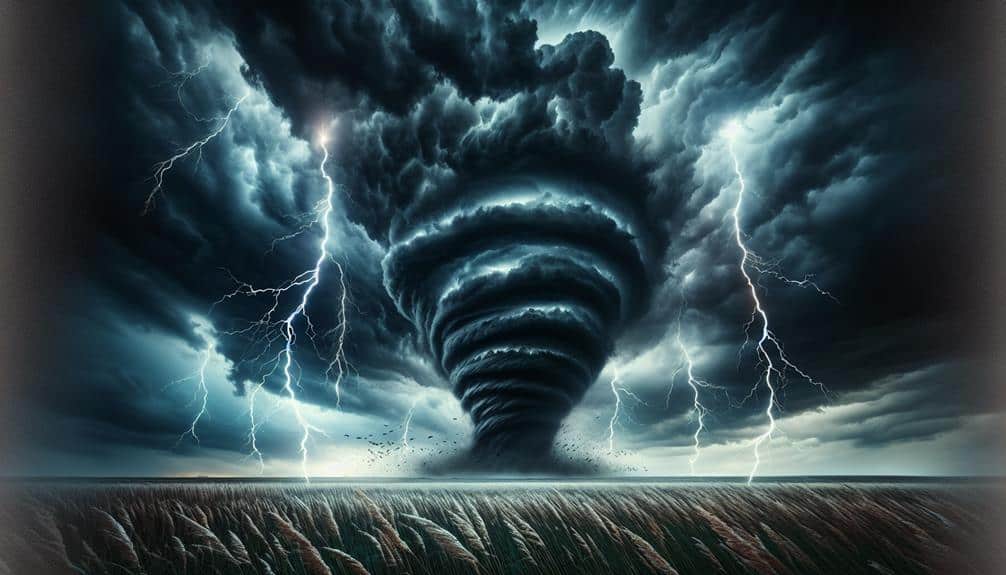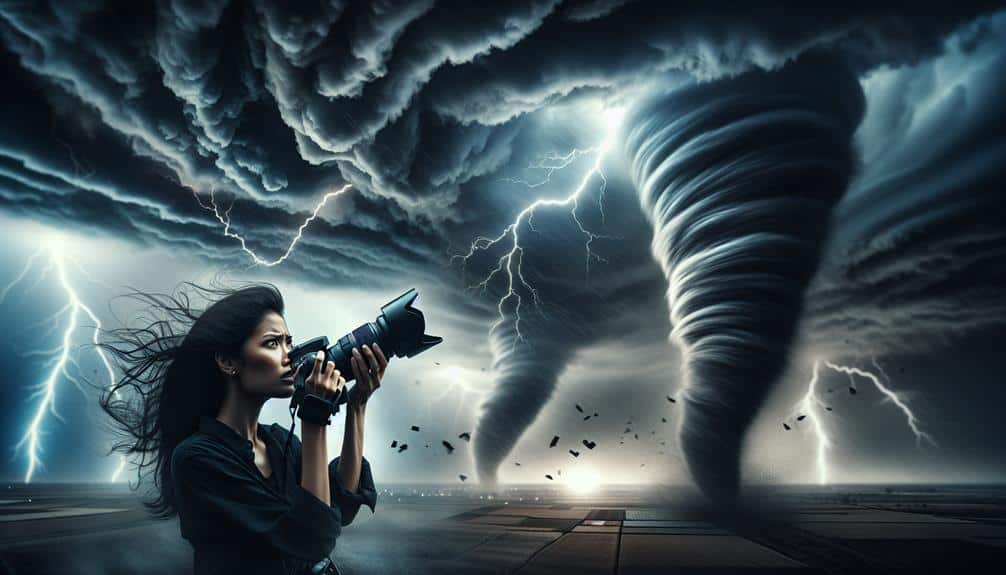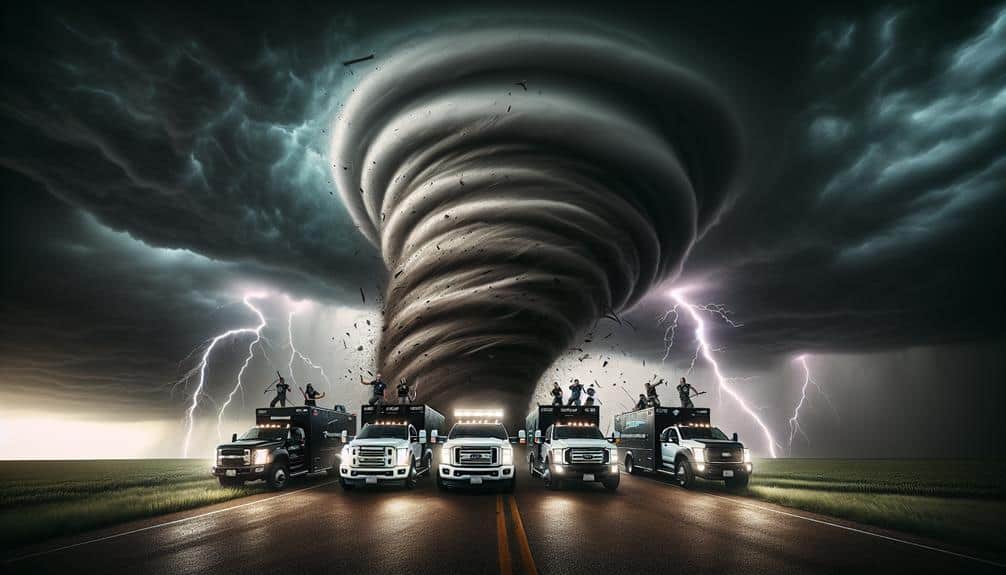We embrace nature's raw fury, armed with high-speed cameras, robust lenses, and weatherproof cases. Venturing into Tornado Alley or the Caribbean during hurricane season, we capture the spectacular violence of the skies. Real-time radar apps and GPS devices guide us through treacherous conditions, with extra batteries and memory cards at the ready. Safety is paramount, so we maintain our gear and pack emergency supplies. By understanding weather patterns and using creative photography techniques, we immortalize nature's chaos while respecting its power and environmental impact. Join us as we reveal the secrets to capturing these thrilling encounters.
Key Points
- Use high shutter speeds and wide apertures to capture sharp, dynamic images of extreme weather conditions.
- Track storms using real-time satellite data and radar apps for accurate positioning and safety.
- Equip your vehicle with emergency supplies and ensure your gear is weatherproof and well-maintained.
- Follow ethical guidelines by minimizing environmental impact and respecting local wildlife during storm chasing.
Essential Gear
When we're gearing up to capture extreme weather, it's important to have the right equipment to withstand nature's fury and guarantee our safety. The adrenaline rush of chasing a storm, the sheer power of nature unleashed, it's all breathtaking. But to truly capture these moments, our gear must be as resilient as our spirit.
First, let's talk camera settings. We need cameras that can handle the fast-changing light and unpredictable elements. High shutter speeds and wide apertures are essential to freeze the action and capture every detail. Don't forget to pack multiple lenses—telephoto for distant tornadoes, wide-angle for vast storm clouds. And always shoot in RAW to preserve the most detail for post-processing.
Protective gear isn't just for us, but for our equipment too. Weatherproof cases and lens hoods are a must. Technology advancements have given us rugged cameras that can withstand rain, wind, and even hail.
Storm tracking has also come a long way. With real-time satellite data and sophisticated radar apps, we can predict the storm's path and position ourselves for the best shots. It's a blend of art and science, and it's what makes capturing extreme weather so vital.
Safety Precautions
When we're out in the wild chasing extreme weather, safety isn't just a guideline—it's our lifeline.
We need to guarantee our essential gear checklist is foolproof and have a rock-solid emergency response plan ready to go.
Let's gear up and stay sharp, because our lives depend on it.
Essential Gear Checklist
Before we explore the elements to capture the raw beauty of extreme weather, we need to make sure our essential gear checklist is thorough and meticulous for our safety.
First and foremost, our gear maintenance is non-negotiable. We must inspect our cameras, lenses, and drones regularly to make sure they're in prime condition. Extreme weather conditions can be harsh, so our equipment needs to withstand rain, hail, and high winds. Waterproof cases, lens hoods, and sturdy tripods are our best allies.
Let's not overlook budget options. High-quality gear doesn't always mean breaking the bank. Researching cost-effective alternatives like second-hand weather-resistant cameras or DIY protective gear can save us a fortune without compromising quality.
Specialized equipment is crucial too. Wind meters, portable weather radios, and GPS devices keep us informed and safe. They provide real-time data, helping us make swift decisions when the storm's intensity is at its peak.
Packing extra batteries and memory cards ensures we don't miss a single shot. And, of course, reliable transportation like a well-maintained vehicle equipped with emergency supplies is essential for ensuring safe passage on challenging roads. Safety first, adventure always.
Emergency Response Plan
To navigate the dangerous terrains of extreme weather photography, we must craft a strong emergency response plan that ensures our safety and enables us to capture nature's fury without compromise. Our adventure hinges on preparation and precision. Before we set out, we need clear communication strategies in place. We'll use satellite phones, radios, and backup batteries to guarantee we're always connected, even when cell service fails us.
Knowing our evacuation routes is equally vital. We should map out multiple exits from our chosen location, considering the swift and unpredictable nature of storms. GPS devices loaded with offline maps will be our guiding stars, making sure we can find our way no matter what.
In the heat of the chase, our passion for capturing the perfect shot must never overshadow our commitment to safety. We'll designate a safety coordinator within our team, someone who'll monitor weather updates and make real-time decisions.
Lastly, let's practice mock drills to stay sharp. Simulating emergency scenarios will help us react instinctively when seconds count.
With this robust emergency response plan, we can embrace the freedom of storm chasing, confident in our readiness for whatever nature throws our way.
Weather Patterns

Weather patterns, with their intricate dance of winds, pressure systems, and temperatures, paint a vivid tapestry that we can't help but marvel at and seek to understand. As storm chasers, we're on the front lines, witnessing firsthand the raw power and beauty of nature's most extreme phenomena. Our passion drives us to explore deeply into meteorological data, reading the atmospheric conditions like an ancient, living map.
Climate change adds an unpredictable twist to this dance, altering established patterns and pushing the boundaries of what we thought we knew. It's a call to sharpen our forecasting techniques, to adapt and innovate as the climate evolves. We rely on cutting-edge technology and time-tested methods alike, marrying the old with the new to predict where the next storm will strike.
Every low-pressure system, every shift in the jet stream, tells a story. We interpret these tales through meteorological data, sifting through layers of atmospheric conditions to uncover the narrative of the skies. With each chase, we become more attuned to nature's signals, more adept at reading the winds and clouds.
Together, we embrace the unknown, driven by the thrill of the chase and the quest for understanding.
Best Locations
As we hone our skills in reading the atmospheric tapestry, pinpointing the best locations to witness and capture extreme weather becomes our next exhilarating challenge.
Let's immerse ourselves in the adventure, seeking the prime spots that promise the most thrilling encounters with nature's raw power.
First on our list of top picks is Tornado Alley in the United States. Stretching across states like Texas, Oklahoma, and Kansas, this region is a storm chaser's dream, offering a plethora of tornadoes during spring and early summer. The flat terrain provides unobstructed views, making it an ideal destination for capturing those dramatic funnel clouds.
Next, we venture to the Great Plains, another must-see location for extreme weather. Known for its severe thunderstorms and mesmerizing lightning displays, this area spans from North Dakota to Texas. Its vast, open landscapes allow us to witness the full fury of Mother Nature.
For those craving a more tropical setting, the Caribbean during hurricane season is unbeatable. Islands such as Puerto Rico and the Bahamas become prime spots for capturing the sheer intensity of hurricanes. The contrast between the serene blue waters and the storm's chaos creates breathtaking imagery.
Ready your gear, fellow adventurers—nature's most magnificent spectacles await!
Photography Techniques

When we set out to capture the raw power of extreme weather, mastering the right photography techniques becomes our most essential ally in immortalizing these breathtaking moments. We thrive on the thrill, the rush, the sheer unpredictability of nature's fury. To seize these moments, we need to dial in our exposure settings with precision. A fast shutter speed can freeze the ferocity of lightning, while a slower one captures the haunting trails of a tornado.
Composition techniques are our artistic compass. Rule of thirds can guide the eye to the storm's epicenter, while leading lines draw viewers into the heart of the chaos. Don't be afraid to experiment; sometimes breaking the rules yields the most dramatic results.
Lighting conditions are our wild card. We chase the golden hour for its ethereal light but must adapt when the sky darkens with tempestuous clouds. Bracketing shots helps us capture varying exposures, ensuring we don't lose detail in the shadows and highlights.
Post-processing tips are vital for refining our raw captures. Adjusting contrast and sharpness can enhance the storm's drama, while color correction brings the scene to life. Let's embrace the storm, camera in hand, and capture its essence.
Ethical Considerations
While we're driven by the thrill of capturing nature's fury, we must also weigh the ethical implications of our pursuits. As storm chasers, we've a responsibility to minimize our environmental impact. It's crucial not just about the perfect shot; we must adopt responsible practices that respect the natural world we so passionately document.
Avoiding unnecessary off-road driving, respecting local wildlife, and not leaving any trash behind are just a few ways we can tread lightly on the land we explore.
Public safety should always be our top priority. When we chase storms, we often find ourselves in small communities that may not be prepared for the extreme weather barreling towards them. Sharing real-time information with local authorities and residents can save lives.
We must set clear ethical boundaries, ensuring our quest for dramatic footage doesn't put others at risk. Remembering that no photograph is worth endangering human lives is crucial.
Ultimately, our adventures are about more than just the adrenaline rush. By practicing environmental stewardship and prioritizing public safety, we can continue to chase storms while honoring the world and people around us.
Frequently Asked Questions
How Do Storm Chasers Communicate During Expeditions?
We use state-of-the-art technology and strategies to communicate during expeditions, ensuring safety is paramount. Our equipment includes radios, GPS, and mobile apps. We're constantly in touch, ready to face nature's fury head-on with unyielding passion.
What Training or Education Is Beneficial for Aspiring Storm Chasers?
We'd recommend diving into meteorology education to understand weather patterns and getting emergency response training to handle dangerous situations. This combo fuels our passion for adventure while ensuring we're prepared for anything nature throws at us.
How Do Storm Chasers Fund Their Expeditions?
We navigate financial challenges by exploring diverse fundraising methods and seeking sponsorship opportunities. Our budgeting strategies involve meticulous planning and leveraging our passion for the storm-chasing adventure to secure necessary funds and guarantee our expeditions' success.
What Are Some Common Misconceptions About Storm Chasing?
People often think storm chasing is all about thrill seeking due to media portrayal, but we prioritize safety precautions. The risks are real, and our passion lies in understanding nature, not just the adrenaline rush.
Can Storm Chasing Be a Full-Time Career?
Ahoy, can storm chasing be a full-time career? Absolutely! We find immense job satisfaction and career sustainability. However, financial stability and work-life balance can be challenging. But the thrill of the chase makes it all worthwhile!


